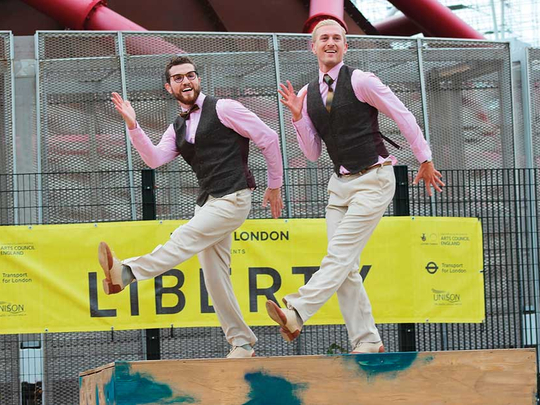
Of all the places to meet a stranger and cook up a dance show together, Mark Smith and Ray Batchelor met on LinkedIn.
Smith, the founder of all-male dance troupe Deaf Men Dancing, and Batchelor, a Tango teacher for D/deaf CAN Dance!, crossed paths on the job-search website, and decided to stir their shared interests and expertise into one lively, bubbling pot.
Embrace was the result — an hour-long performance flourishing at the crossroads between dance and disability, and arriving at the Dubai Opera Promenade on November 6, from 6-7pm. In the show, two strangers meet for the first time and must embrace each other through the art of tango and sign language.
DANCE AS LANGUAGE
Embrace is, ultimately, an exercise in trust and openness, said Smith — one that he hopes will rub off on its audiences. The idea came to him while he was taking a walk in the park one day.
“I heard beautiful music and wondered where it came from. I discovered a group of adults dancing tango on the bandstand,” he said.
He was inspired by his discovery, and watched the display for a long time. He later studied videos of groups and partners dancing tango online, coming across a video of Batchelor teaching deaf adults how to tango. It gave him the idea to incorporate the style of dance into his ongoing work at Deaf Men Dancing. The troupe typically uses sign language in its choreography, and Smith found that there was a parallel between signing and dancing with another person.
“I can see the similarity with tango because the dancers communicate with their partner and use their physicality as language. Tango is about communication and emotion,” he said.
Tango, a partner dance associated with its passionate and romantic undertones, goes back to the 19th century. It emerged along the River Plata, between Argentina and Uruguay, in the mid-1800s. Its evolution is steeped in fable, but it is largely accepted that tango was first formed by enslaved African peoples in Argentina; the word ‘tango’ was used to refer to an area where they came together to dance.
CHANGING PERCEPTIONS
Embrace, much like Smith’s other global and national productions, is a step towards changing the public’s perceptions around “deaf and disability dance”, he said, so that it will one day become equal to mainstream dance.
Smith founded Deaf Men Dancing in the UK in August of 2010, and has since operated as its Artistic Director. The collective brings together professional male dancers who, like Smith, are deaf and, through several key productions, shift pre-existing notions around their artistic expression.
“I like to push the boundaries and change people’s perspective of deaf dance,” explained Smith. “My work is thought-provoking. I like making people think and encourage debate about the work.”
Embrace is part of the UK/UAE Year of Creative Collaboration, “a season of arts and events in the UAE aimed at building new audiences, creating new collaborations and strengthening relationships”, according to the British Council’s website.
It will be the first show to have taken place on the Dubai Opera Promenade. No tickets are required to attend, as the performance is free and open to the public.
In the meantime, Smith has a piece of advice for any deaf or hard-of-hearing individuals in the UAE who would like to become active in the realm of performing arts:
“Believe in yourself. Follow your dream. Never give up. There is no such word as ‘Can’t’. Embrace the challenge. Never stop learning. Be inspired every day. Focus on your strength in performance,” he said.
Don’t miss it
Embrace is a free performance. Show starts at 6pm at the Dubai Opera Promenade.









